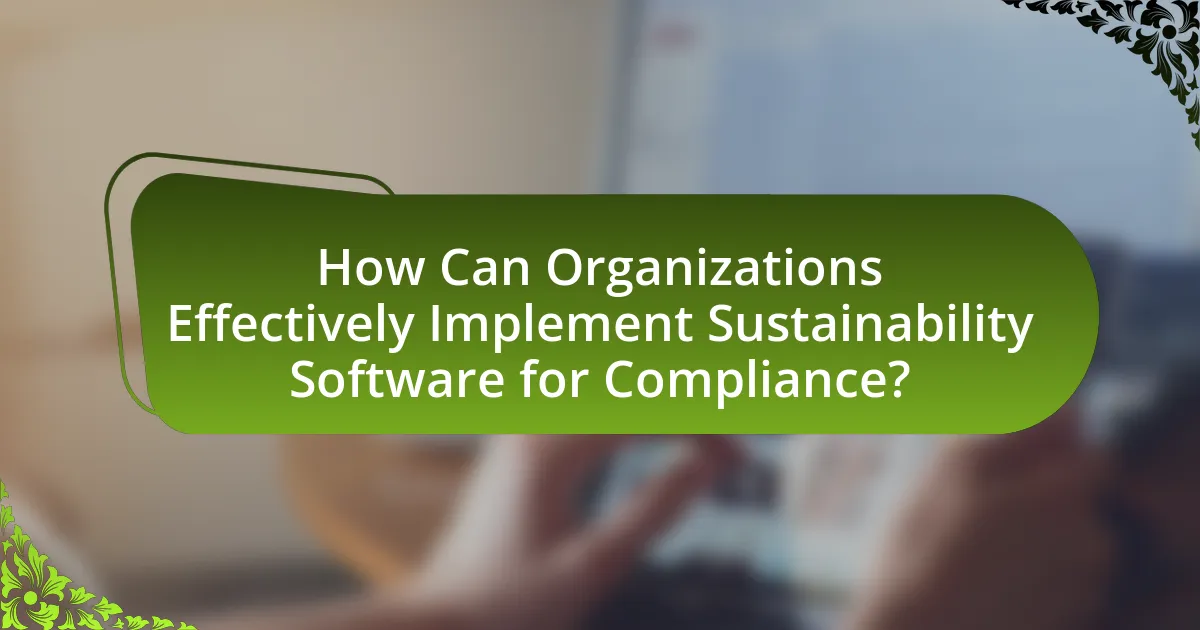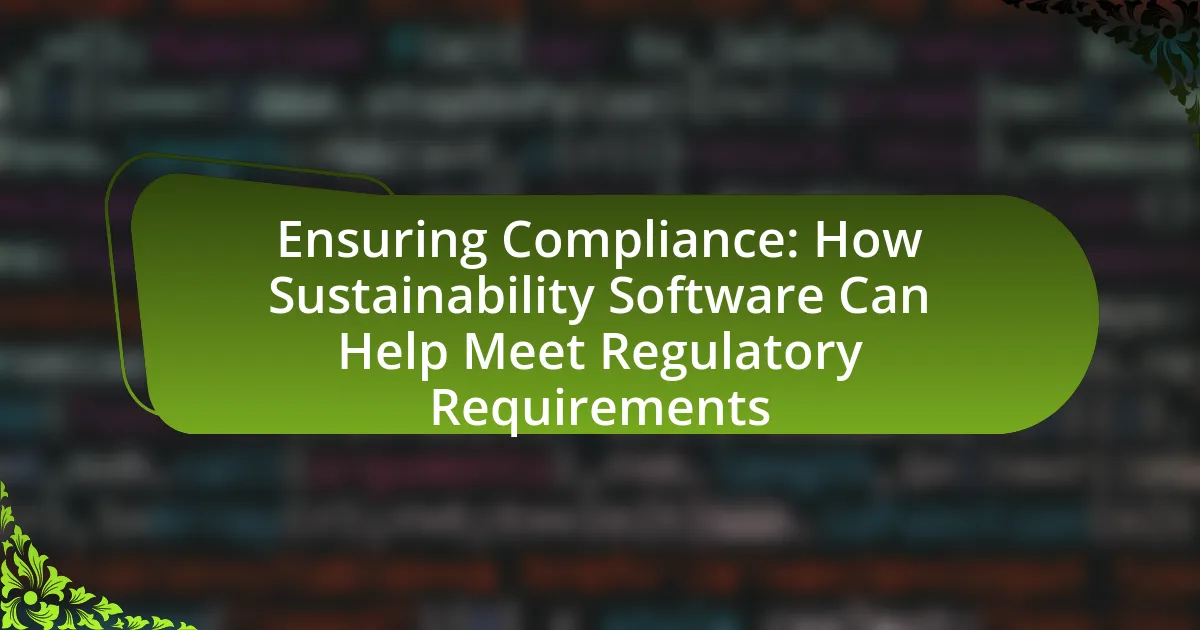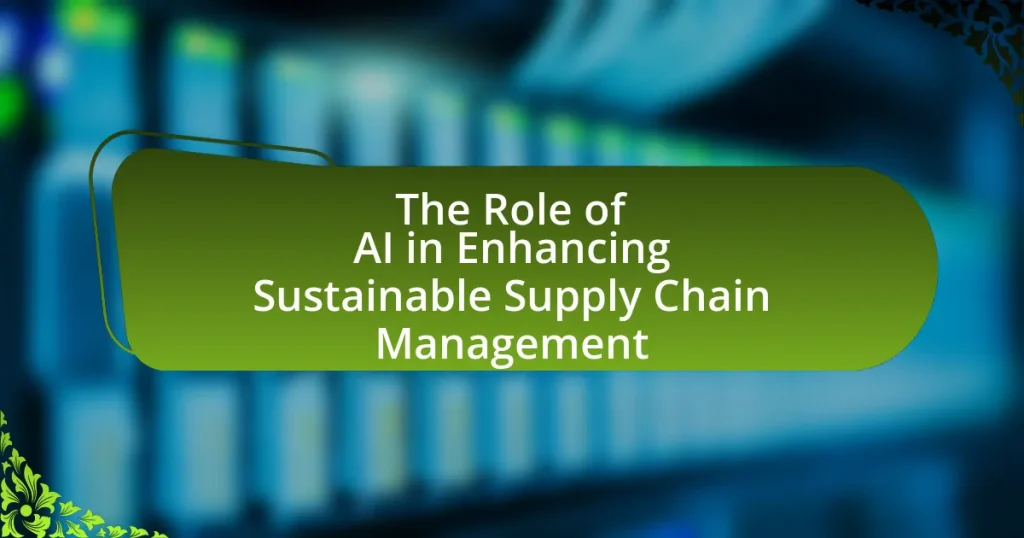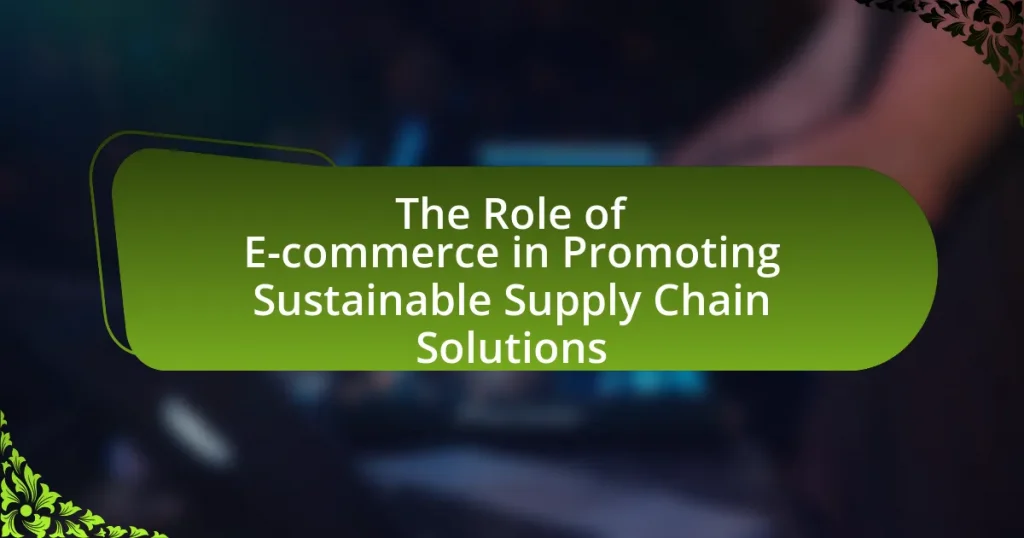Sustainability software is a digital tool that assists organizations in tracking, managing, and reporting their environmental, social, and governance (ESG) performance, playing a vital role in ensuring compliance with regulatory requirements. This article explores how sustainability software automates data collection and reporting processes, helping businesses adhere to various environmental regulations while promoting transparency and accountability. Key features such as automated reporting, data tracking, and risk assessment tools are highlighted, along with the importance of compliance for enhancing corporate reputation and stakeholder trust. Additionally, the article addresses the challenges organizations face in implementing sustainability software and offers practical tips for maximizing compliance outcomes.

What is Sustainability Software and Its Role in Compliance?
Sustainability software is a digital tool designed to help organizations track, manage, and report their environmental, social, and governance (ESG) performance. Its role in compliance is critical, as it enables businesses to adhere to regulatory requirements by providing accurate data collection, analysis, and reporting capabilities. For instance, sustainability software can automate the gathering of emissions data, ensuring compliance with regulations such as the European Union’s Emissions Trading System, which mandates precise reporting of greenhouse gas emissions. By facilitating transparency and accountability, sustainability software supports organizations in meeting legal obligations while promoting sustainable practices.
How does sustainability software help organizations meet regulatory requirements?
Sustainability software assists organizations in meeting regulatory requirements by automating data collection and reporting processes. This software enables companies to track their environmental impact, ensuring compliance with local, national, and international regulations. For instance, organizations can utilize sustainability software to monitor greenhouse gas emissions, waste management, and resource consumption, which are often mandated by environmental laws. By providing real-time analytics and compliance dashboards, sustainability software helps organizations identify areas of non-compliance and rectify them promptly, thereby reducing the risk of penalties and enhancing overall regulatory adherence.
What are the key features of sustainability software that support compliance?
Key features of sustainability software that support compliance include automated reporting, data tracking, regulatory updates, and risk assessment tools. Automated reporting streamlines the generation of compliance documents, ensuring timely submissions to regulatory bodies. Data tracking capabilities allow organizations to monitor their environmental impact and resource usage, which is essential for meeting legal requirements. Regulatory updates keep users informed about changes in laws and standards, facilitating proactive compliance management. Risk assessment tools help identify potential compliance risks, enabling organizations to address issues before they escalate. These features collectively enhance an organization’s ability to adhere to sustainability regulations effectively.
How does data collection in sustainability software facilitate regulatory reporting?
Data collection in sustainability software facilitates regulatory reporting by systematically gathering and organizing relevant environmental, social, and governance (ESG) data required for compliance. This software automates the collection of metrics such as carbon emissions, energy consumption, and waste management, ensuring that organizations can easily compile accurate reports that meet regulatory standards. For instance, the Global Reporting Initiative (GRI) provides guidelines that require specific data points, which sustainability software can track and report efficiently, thereby reducing the risk of non-compliance and potential penalties.
Why is compliance important for businesses in the context of sustainability?
Compliance is important for businesses in the context of sustainability because it ensures adherence to environmental regulations, which helps mitigate risks and enhances corporate reputation. By following legal standards, companies can avoid penalties and legal issues, as evidenced by the fact that non-compliance can lead to fines that average $2.7 million per incident. Furthermore, compliance fosters trust among consumers and stakeholders, as 66% of global consumers are willing to pay more for sustainable brands, indicating that adherence to sustainability regulations can drive profitability and market competitiveness.
What are the potential consequences of non-compliance with sustainability regulations?
Non-compliance with sustainability regulations can lead to significant financial penalties and legal repercussions for organizations. For instance, companies may face fines that can reach millions of dollars, depending on the severity of the violation and the specific regulations breached. Additionally, non-compliance can result in reputational damage, leading to loss of customer trust and decreased market share. According to a report by the World Economic Forum, businesses that fail to adhere to sustainability standards risk losing up to 30% of their revenue due to consumer backlash and increased scrutiny from stakeholders. Furthermore, organizations may encounter operational disruptions, as regulatory bodies can impose restrictions or halt operations until compliance is achieved.
How can compliance enhance a company’s reputation and stakeholder trust?
Compliance enhances a company’s reputation and stakeholder trust by demonstrating a commitment to ethical practices and regulatory adherence. When a company consistently meets legal and industry standards, it builds credibility with stakeholders, including customers, investors, and regulators. For instance, a 2021 study by the Ethics & Compliance Initiative found that organizations with strong compliance programs experience 50% fewer incidents of misconduct, which directly correlates with improved public perception and trust. Additionally, companies that prioritize compliance often enjoy better relationships with regulatory bodies, leading to a more favorable operating environment and increased stakeholder confidence.

What are the Different Types of Regulatory Requirements Addressed by Sustainability Software?
Sustainability software addresses various regulatory requirements, including environmental compliance, carbon emissions reporting, waste management regulations, and sustainability disclosures mandated by financial authorities. These software solutions help organizations track and report their compliance with laws such as the Clean Air Act, the Resource Conservation and Recovery Act, and the European Union’s Non-Financial Reporting Directive. By automating data collection and reporting processes, sustainability software ensures that companies meet their legal obligations while also enhancing transparency and accountability in their sustainability practices.
How do environmental regulations impact business operations?
Environmental regulations significantly impact business operations by imposing compliance requirements that can alter production processes, increase operational costs, and necessitate changes in resource management. For instance, companies must invest in cleaner technologies and sustainable practices to meet emissions standards, which can lead to higher initial capital expenditures. According to a study by the World Bank, businesses that comply with environmental regulations often experience a 10-20% increase in operational costs due to the need for new equipment and training. Additionally, failure to comply can result in substantial fines and legal repercussions, further influencing operational strategies. Thus, environmental regulations compel businesses to adapt their operations to ensure compliance, ultimately affecting their profitability and market competitiveness.
What specific environmental regulations can sustainability software help manage?
Sustainability software can help manage specific environmental regulations such as the Clean Air Act, the Clean Water Act, and the Resource Conservation and Recovery Act. These regulations require organizations to monitor emissions, manage waste, and ensure water quality, which sustainability software can facilitate through data collection, reporting, and compliance tracking. For instance, the Clean Air Act mandates the monitoring of air pollutants, and sustainability software can automate the reporting process to ensure compliance with the Environmental Protection Agency’s standards.
How do international sustainability standards influence local compliance efforts?
International sustainability standards significantly influence local compliance efforts by providing a framework that local entities can adopt to align with global best practices. These standards, such as the ISO 14001 for environmental management, set clear benchmarks that local organizations can use to assess and improve their sustainability practices. For instance, when local businesses adopt ISO 14001, they often see enhanced operational efficiency and reduced environmental impact, which are critical for meeting both local regulations and international expectations. Furthermore, adherence to these standards can facilitate access to international markets, as many global companies require compliance with recognized sustainability standards from their suppliers. This alignment not only helps local entities to comply with local laws but also positions them favorably in the global marketplace, demonstrating a commitment to sustainability that is increasingly demanded by consumers and stakeholders.
What role do industry-specific regulations play in sustainability compliance?
Industry-specific regulations are crucial for ensuring sustainability compliance as they establish mandatory standards and practices that organizations must follow to minimize environmental impact. These regulations guide companies in implementing sustainable practices tailored to their specific industry, such as emissions limits in manufacturing or waste management protocols in the food sector. For instance, the European Union’s Emissions Trading System mandates that power plants and factories reduce greenhouse gas emissions, directly influencing their operational strategies. Compliance with these regulations not only helps organizations avoid legal penalties but also enhances their reputation and competitiveness in the market.
Which industries face the most stringent sustainability regulations?
The industries that face the most stringent sustainability regulations include energy, manufacturing, and agriculture. The energy sector is heavily regulated due to its significant environmental impact, with strict emissions standards and renewable energy mandates enforced in many regions. Manufacturing industries are subject to regulations concerning waste management, emissions, and resource usage, often guided by frameworks such as ISO 14001. Agriculture faces stringent regulations related to pesticide use, water management, and land use practices, driven by both environmental concerns and food safety standards. These regulations are designed to mitigate environmental harm and promote sustainable practices across these critical sectors.
How can sustainability software be tailored to meet industry-specific compliance needs?
Sustainability software can be tailored to meet industry-specific compliance needs by incorporating features that align with the unique regulations and standards of each sector. For example, in the manufacturing industry, software can include modules for tracking emissions and waste management that comply with the Environmental Protection Agency’s regulations. Additionally, the software can be designed to integrate with existing systems to ensure accurate reporting and data collection, which is crucial for compliance audits. Customizable dashboards can provide real-time insights into compliance status, enabling organizations to proactively address any issues. This approach ensures that the software not only meets regulatory requirements but also supports the specific operational needs of the industry, enhancing overall sustainability efforts.

How Can Organizations Effectively Implement Sustainability Software for Compliance?
Organizations can effectively implement sustainability software for compliance by first conducting a thorough needs assessment to identify specific regulatory requirements and organizational goals. This assessment allows organizations to select software that aligns with their compliance needs, such as tracking emissions, waste management, or resource usage.
Next, organizations should ensure proper integration of the software with existing systems to facilitate seamless data flow and reporting. Training staff on the software’s functionalities is crucial, as it enhances user adoption and ensures accurate data entry and reporting.
Furthermore, organizations must establish clear processes for data collection, analysis, and reporting to maintain compliance with regulations. Regular audits and updates to the software are necessary to adapt to changing regulations and improve functionality.
Evidence of successful implementation can be seen in companies like Unilever, which reported a 50% reduction in greenhouse gas emissions per product through the use of sustainability software, demonstrating the effectiveness of such tools in meeting compliance requirements.
What steps should organizations take to integrate sustainability software into their compliance strategy?
Organizations should first assess their current compliance requirements and sustainability goals to effectively integrate sustainability software into their compliance strategy. This assessment allows organizations to identify specific regulatory obligations and sustainability metrics that the software must address. Next, organizations should select sustainability software that aligns with these identified needs, ensuring it offers features for tracking, reporting, and managing compliance data.
Following the selection, organizations must implement the software through a structured plan that includes training staff on its use and integrating it with existing compliance processes. Regular monitoring and evaluation of the software’s performance against compliance objectives are essential to ensure it meets regulatory requirements effectively.
Finally, organizations should establish a feedback loop to continuously improve the integration process, adapting the software and compliance strategies as regulations and sustainability goals evolve. This systematic approach ensures that sustainability software becomes a vital component of the overall compliance strategy, enhancing regulatory adherence and promoting sustainable practices.
How can training and support enhance the effectiveness of sustainability software?
Training and support enhance the effectiveness of sustainability software by ensuring users are proficient in its features and functionalities. When users receive comprehensive training, they can effectively utilize the software to track compliance with regulatory requirements, analyze sustainability metrics, and generate accurate reports. Research indicates that organizations that invest in training see a 30% increase in software utilization rates, leading to improved data accuracy and decision-making. Furthermore, ongoing support helps users troubleshoot issues and adapt to software updates, maintaining operational efficiency and compliance with evolving regulations.
What are common challenges organizations face when implementing sustainability software?
Organizations commonly face challenges such as data integration, user adoption, and regulatory compliance when implementing sustainability software. Data integration issues arise from the need to consolidate information from various sources, which can lead to inconsistencies and inaccuracies. User adoption is often hindered by resistance to change and a lack of training, resulting in underutilization of the software. Additionally, ensuring compliance with evolving regulations can be complex, as organizations must continuously update their practices to align with new legal requirements. These challenges can impede the effective use of sustainability software, ultimately affecting an organization’s ability to meet its sustainability goals.
What best practices should organizations follow to maximize compliance with sustainability software?
Organizations should implement a comprehensive strategy that includes regular training, data accuracy, and stakeholder engagement to maximize compliance with sustainability software. Regular training ensures that employees understand the software’s functionalities and compliance requirements, which is crucial for effective usage. Data accuracy is essential, as reliable data input leads to precise reporting and compliance with regulations. Engaging stakeholders, including suppliers and customers, fosters transparency and accountability, which are vital for meeting sustainability goals. According to a study by the Global Reporting Initiative, organizations that actively involve stakeholders in sustainability practices see a 30% increase in compliance rates.
How can continuous monitoring and reporting improve compliance outcomes?
Continuous monitoring and reporting enhance compliance outcomes by providing real-time insights into regulatory adherence and operational practices. This proactive approach allows organizations to identify and rectify compliance issues promptly, reducing the risk of violations and associated penalties. For instance, a study by the Institute of Internal Auditors found that organizations employing continuous monitoring experienced a 30% reduction in compliance-related incidents compared to those relying on periodic assessments. By integrating sustainability software that automates data collection and reporting, companies can ensure they remain aligned with regulatory requirements, thereby fostering a culture of accountability and transparency.
What role does stakeholder engagement play in successful compliance efforts?
Stakeholder engagement is crucial for successful compliance efforts as it fosters collaboration, transparency, and accountability among all parties involved. Engaging stakeholders, including employees, customers, regulators, and community members, ensures that diverse perspectives are considered, which enhances the identification of compliance risks and the development of effective strategies to mitigate them. Research indicates that organizations with strong stakeholder engagement practices are 30% more likely to achieve compliance with regulatory requirements, as they can better align their policies and practices with stakeholder expectations and legal standards. This alignment not only improves compliance outcomes but also builds trust and credibility, which are essential for long-term sustainability and operational success.
What are the future trends in sustainability software and compliance?
Future trends in sustainability software and compliance include increased integration of artificial intelligence and machine learning for data analysis, enhanced real-time monitoring capabilities, and a focus on user-friendly interfaces. These advancements will enable organizations to automate compliance processes, improve accuracy in reporting, and facilitate better decision-making. For instance, a report by Gartner predicts that by 2025, 75% of organizations will use AI-driven tools for sustainability reporting, reflecting a significant shift towards technology-driven compliance solutions. Additionally, the rise of blockchain technology is expected to enhance transparency and traceability in sustainability practices, further supporting compliance efforts.
How is technology evolving to enhance compliance capabilities in sustainability software?
Technology is evolving to enhance compliance capabilities in sustainability software through the integration of advanced data analytics, artificial intelligence, and blockchain technology. These innovations enable real-time monitoring and reporting of sustainability metrics, ensuring that organizations can swiftly adapt to changing regulatory requirements. For instance, AI algorithms can analyze vast datasets to identify compliance risks and suggest corrective actions, while blockchain provides a transparent and immutable record of sustainability practices, facilitating audits and verification processes. This evolution is crucial as regulatory bodies increasingly demand accurate and timely reporting, with studies indicating that companies leveraging such technologies can reduce compliance-related costs by up to 30%.
What emerging regulations should organizations prepare for in the coming years?
Organizations should prepare for emerging regulations focused on sustainability and environmental impact, such as the European Union’s Corporate Sustainability Reporting Directive (CSRD) and the U.S. Securities and Exchange Commission’s (SEC) proposed climate disclosure rules. The CSRD, effective from 2024, mandates companies to disclose detailed sustainability information, impacting thousands of businesses across Europe. Similarly, the SEC’s proposed rules aim to enhance transparency regarding climate-related risks and their financial implications, requiring public companies to report on their greenhouse gas emissions and climate strategies. These regulations reflect a global trend towards increased accountability in corporate sustainability practices, necessitating organizations to adopt comprehensive sustainability software solutions to ensure compliance and streamline reporting processes.
What practical tips can organizations use to ensure compliance with sustainability software?
Organizations can ensure compliance with sustainability software by implementing regular audits and training programs. Regular audits help identify gaps in compliance and ensure that the software is being used effectively to meet regulatory requirements. Training programs educate employees on the importance of sustainability practices and how to utilize the software properly, which enhances adherence to compliance standards. Additionally, organizations should establish clear policies and procedures that align with sustainability goals, ensuring that all stakeholders understand their roles in maintaining compliance.



